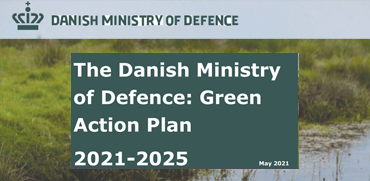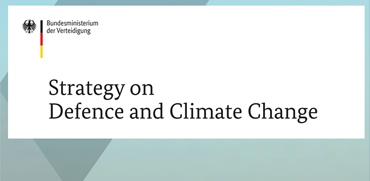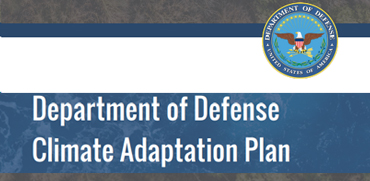
The European Commission (EC), the European Union External Action Service (EEAS), and the European Defence Agency (EDA) are exploring the challenges and opportunities of green public procurement for defence, aiming to integrate sustainability into procurement practices. They are also establishing mechanisms, like the Climate and Defence Support Mechanism and a Climate, Security and Defence Training Platform, to address climate adaptation and mitigation in military operations.

The Czech Republic’s outlines how the Ministry of Defence will strengthen resilience and sustainability in national defence while aligning with the State Energy Policy. Priorities include securing reliable energy supplies, and promoting sustainable management across the sector. The Ministry will integrate circular economy principles to extend material life cycles, minimise waste, optimise maintenance and end-of-life management, as well as in (green) procurement. The Ministry will promote the participation of Czech entities in international defence R&D initiatives to promote sustainable innovation.
Efforts focus on energy transition, securing supply chains (including Critical Raw Materials), resource independence, and environmental protection, drawing on the European Critical Raw Materials Act.

The Danish Ministry of Defence is committed to leading the green transition within national defence, balancing environmental goals with operational needs.
The Green Action Plan 2021–2025 aims to strengthen sustainability, operational resilience, and independence in supply chains linking environmental responsibility with security of supply. It supports the development of new technological solutions to make the Armed Forces greener through cooperation with industry, academia, and research institutions. Climate-conscious procurement and energy-efficient solutions are key tools for reducing emissions and improving long-term readiness. By linking environmental goals with security of supply and innovation, Denmark seeks to ensure that defence capabilities remain robust, adaptable, and aligned with national climate commitments.

The Defence Climate Strategy 2024 outlines the Finnish Ministry of Defence’s commitment to strengthening national preparedness through sustainable and energy-efficient operations. Securing the energy supply in both normal and emergency conditions is identified as essential to defence readiness. By improving energy efficiency and increasing the use of alternative energy sources, the Defence Administration seeks to enhance performance, reduce costs, improve security of supply, and lower operational vulnerability.
The strategy integrates energy efficiency and climate considerations into all defence projects, procurement processes, and life-cycle management. It also advances Finland’s broader climate and circular-economy objectives, ensuring that environmental sustainability supports the long-term resilience and operational capability of the Finnish Defence Forces.

The French defence procurement agency (“DGA”) is addressing climate risks early in the procurement process, ensuring equipment remains effective over long lifecycles, despite evolving environmental conditions. They will enhance climate risk anticipation and integrate feedback from the field more rapidly into future designs, ensuring long-term technological superiority of weapons systems through continuous innovation and improved planning.

The “Bundeswehr” is adapting to climate change by preparing personnel and ensuring military equipment can operate under extreme conditions. This includes incorporating synthetic fuels and alternative energy sources, enhancing the resilience of defence infrastructure, and updating logistics for battlefield mobility. Climate considerations are integrated into planning, procurement, and capability development processes, with a focus on long-term agility, dynamic technological solutions, and alignment with NATO’s requirements.

The Climate Change Adaptation and Mitigation Roadmap of the Armed Forces embeds green procurement and circular economy principles into Greece’s defence policy. Procurement practices will favour systems, materials, and equipment with lower energy and carbon footprints, prioritising life-cycle performance. Environmentally responsible end-of-life disposal and long-term partnerships with domestic and international suppliers will support resource efficiency and sustainable supply chains.
Circular economy actions include waste reduction, reuse, recycling, and environmentally aware production within the Armed Forces. The roadmap encourages adoption of mature technologies and Life-Cycle Analysis (LCA) in procurement and maintenance. The aim is to reduce environmental impact while enhancing resilience and aligning with EU / NATO green defence and sustainability goals.

Luxembourg’s Defence Guidelines 2035 set out a long-term vision for strengthening national and European security while supporting sustainable defence transformation. Particular emphasis is placed on green technologies as drivers of operational efficiency and resilience. Integrating such technologies from the outset of capability development enhances operational autonomy, optimises supply chains, improves security of supply, and reduces the overall carbon footprint.
Circular economy principles are promoted across defence and related industries, encouraging reuse to prevent supply vulnerabilities and reduce waste. Securing supply chains is recognised as critical to ensure that both defence and civilian industries can deliver essential equipment and dual-use technologies reliably and on schedule.

Portugal’s National Defence Strategy for the Environment, Security and Climate Change is integrating climate resilience into military planning, operations, and infrastructure to ensure readiness in the face of environmental challenges. The Portuguese Ministry of Defence promotes energy transition, resource efficiency, and environmental protection while safeguarding operational effectiveness.
Circular-economy principles are advanced through extending product lifecycles, reducing waste, and embedding environmental criteria into acquisition and maintenance processes. Efforts aim to strengthen sustainability in logistics and supply chains while supporting national climate objectives. By enhancing environmental performance and resilience simultaneously, Portugal seeks to ensure that defence capabilities remain robust, adaptable, and aligned with evolving climate-related challenges..

The Spanish Ministry of Defence is responding to climate change by enhancing resilience and maintaining operational readiness across all Armed Forces. The strategy focuses on adapting infrastructure, equipment, and logistics to extreme weather conditions, while integrating climate risks into planning and operations. It also supports national and international emergency response efforts linked to climate-related events. The strategy incorporates circular economy principles and strengthens environmental criteria in defence procurement, aiming to reduce waste, improve lifecycle sustainability, and minimize the carbon footprint of military operations.
Overall, Spain positions climate adaptation and sustainability as essential components of maintaining capability and long-term operational effectiveness.

The Swedish Defence Sector’s "Criteria Document" regulates the use of chemical substances in products like vehicles, uniforms, and electronics to minimise environmental and health risks. It sets stricter requirements than current EU legislation (REACH, CLP), restricting harmful chemicals such as carcinogens, mutagens, and greenhouse gases. By updating annually and ensuring compliance from both EU and non-EU suppliers, the document supports Sweden's national goal of achieving a "Non-toxic Environment" while promoting safer chemical development.

The Norwegian defence sector is committed to reducing its climate footprint while maintaining operational readiness, with a strong focus on circular economy and sustainable procurement. The strategy emphasizes cutting emissions, transitioning to renewable energy, and integrating climate considerations into planning, training, and innovation. Procurement processes are being redesigned to prioritize lifecycle assessments, reuse, and recycling, aligning with circular economy principles. The strategy also includes protecting biodiversity and cultural heritage, phasing out hazardous substances, and adapting operations to extreme weather. Strong interagency cooperation and alignment with NATO, EU, and UN sustainability goals underpin Norway’s defence climate strategy.

The Canadian Defence Department emphasizes green procurement by integrating environmental and energy considerations into purchasing decisions. Updated directives promote carbon reduction, sustainable materials, and green technologies, particularly in construction and packaging. Defence aims to procure energy-efficient military equipment with a life-cycle approach to minimise environmental impacts and operational costs, while also working on a sustainable packaging solution through consultations with industry.

The U.S. Department of Defense (DOD) is integrating climate adaptation and cost management, including life-cycle costs, into procurement strategies and infrastructure management to mitigate climate-related risks. This involves updating cost estimation and investment processes, driving transparency across supply chains, and emphasizing sustainable procurement to minimise environmental impacts. The DOD aims to enhance resilience by leveraging collaborative adaptation strategies and improving the sustainability of critical infrastructure and supply chains.